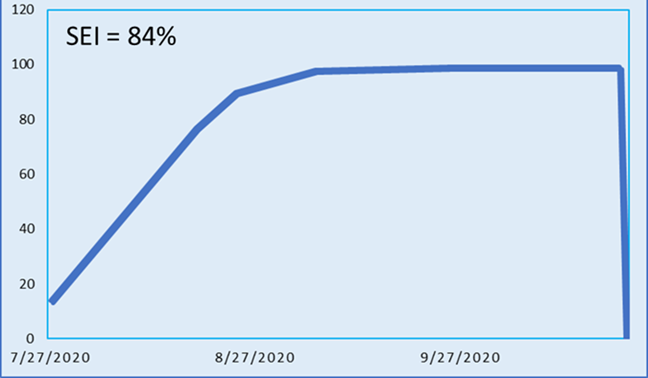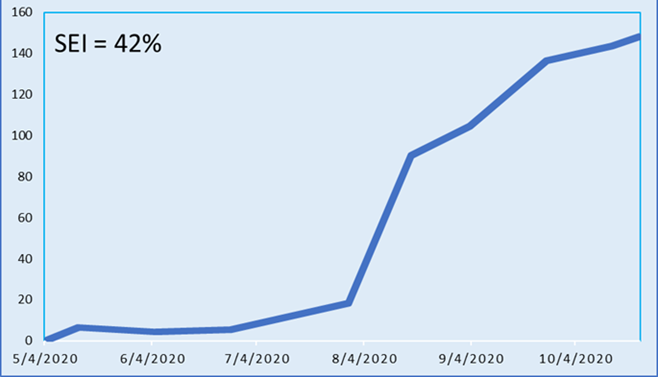Analysis Shows Differences in COVID-19 Vaccine Trial Recruitment
Analysis from Phesi shows the enrollment and effectiveness of two current COVID-19 vaccine trials conducted by global pharmaceutical development companies.
Analysis from virtual clinical development specialist Phesi shows the enrollment and effectiveness of two current COVID-19 vaccine trials conducted by global pharmaceutical development companies. On the surface, both trials appear to be on track to complete enrollment, however, looking deeper, there is a significant difference in the Site Effectiveness Index (SEI) between the two, with trial A scoring 84 percent and trial B scoring 39 percent. SEI is a metric to measure how effectively a clinical trial site activation process is executed.
Trial A completed enrollment on October 22, 2020, with 30,000 subjects, activating 99 sites in three months. After adjustment for site activation, each site enrolled 4.15 subjects per day. Trial B has activated 149 sites by October 22nd, 2020 but has been recruiting for over five and a half months.
Dr. Gen Li, President of Phesi, commented, “We estimate that it will take 175 sites to be activated and six months for Trial B to enroll its target of 43,998 subjects. If we make the same site activation adjustment (SEI 42 percent) it would enroll 3.75 subjects per day, significantly lower than Trial A.”

Figure 1. Trial A

Figure 2. Trial B
“This difference contributes significantly to the disparity in the observed SEI levels between the two trials, but another contributing factor is that Trial B has implemented a number of protocol amendments. Making protocol amendments is a known factor in many trials exceeding their projected timeframe and budget,” said Dr Li.
The amendments to Trial B included reducing the restrictions on the age of subjects and altering the target number to enroll from 8640 patients, to 7600, then 32,000, then 29,481. It now targets to enroll 43,998 subjects. Trial B also has an adaptive trial design, which should theoretically lead to an overall shorter development cycle, bringing the vaccine to patients faster – but often at the expense of higher financial costs.
“The data from the two trials show that in the hunt for a COVID-19 vaccine, there is varying success in activating investigator sites and enrolling patients, which must be tackled to accelerate development,” continued Dr Li. “In this comparison, the difference of enrollment cycle times between the two trials is three months vs. six months – a considerable time period in a global pandemic. Bringing innovative and life-saving medicines to patients is complicated and capital intensive. The solution to improving SEI and accelerating development requires a deep understanding of real-time, dynamically refreshed data and a forensic examination of the
Improving Relationships and Diversifying the Site Selection Process
April 17th 2025In this episode of the Applied Clinical Trials Podcast, Liz Beatty, co-founder and chief strategy officer, Inato, discusses a number of topics around site engagement including community-based sites, the role of technology in improving site/sponsor relationships, how increased operational costs are impacting the industry, and more.
Behind the Buzz: Why Clinical Research Leaders Flock to SCOPE Summit
February 7th 2025In this episode, we meet with Micah Lieberman, Executive Conference Director for SCOPE Summit (Summit for Clinical Ops Executives) at Cambridge Innovation Institute. We will dive deep into the critical role of collaboration within the clinical research ecosystem. How do we bring together diverse stakeholders—sponsors, CROs, clinical trial tech innovators, suppliers, patients, sites, advocacy organizations, investors, and non-profits—to share best practices in trial design, program planning, innovation, and clinical operations? We’ll explore why it’s vital for thought leaders to step beyond their own organizations and learn from others, exchanging ideas that drive advancements in clinical research. Additionally, we’ll discuss the pivotal role of scientific conferences like SCOPE Summit in fostering these essential connections and collaborations, helping shape the future of clinical trials. Join us as we uncover how collective wisdom and cross-industry partnerships are transforming the landscape of clinical research.
FDA-Approved Gene Therapy Beqvez Shows Sustained Efficacy, Safety in Long-Term Hemophilia B Trial
April 17th 2025Beqvez (fidanacogene elaparvovec), an FDA-approved one-time gene therapy for hemophilia B, demonstrated sustained factor IX expression, low bleeding rates, and a favorable safety profile over long-term follow-up.